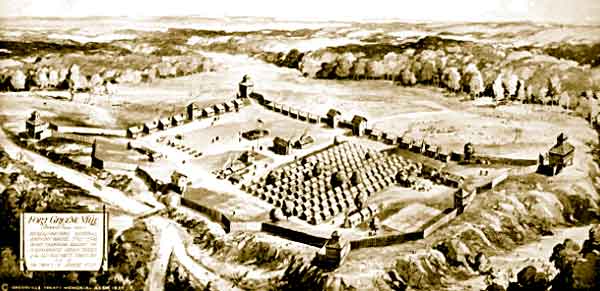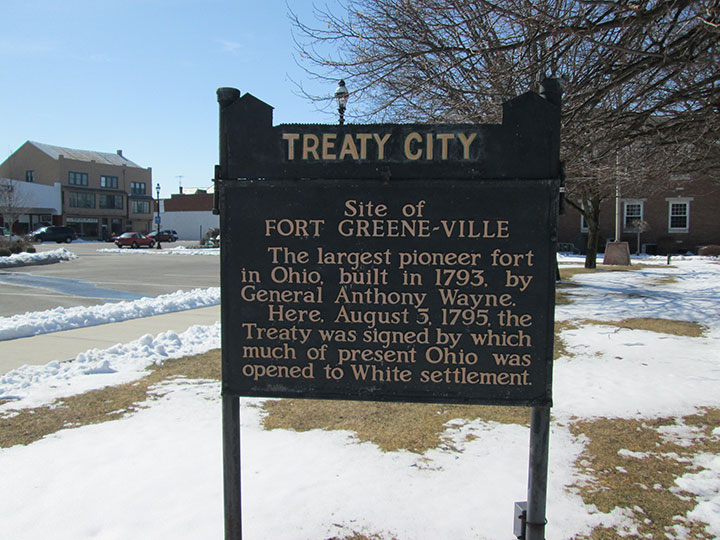The fort at Greene Ville was built in 1793 during the American Indian Wars in present day Greenville, Ohio. After General Anthony Wayne’s victory at the Battle of Fallen Timbers, the Treaty of Greenville was signed in August of 1795 by both Delaware and Wyandot tribes and the United States at the Fort. The treaty marked the end of the Northwest Indian Wars and negotiated the land boundary between the settlers and natives.

The fort was built in 1793 and was one of the largest wooden fortifications to have ever been built at the time (Touring Ohio, 2019). The fort enclosed about 55 acres and was surrounded by a 10 foot high fence. There was also 8 block houses built 250 yards outside of the main wall to provide additional defenses. The fort was set up much like a city which was unusual for the time period.General Anthony Wayne named the fort after a good friend of his, the late Nathaniel Greene whom he served alongside in the American Revolution. Nathaniel Greene died a few years before Wayne’s expedition at his Georgia home due to heat stroke at the early age of 43 (Touring Ohio).
Nathaniel Greene and Anthony “Mad Anthony” Wayne

Nathaniel Greene was born in 1742 in Potowomut, Rhode Island to an upper class Quaker family. Greene loved to read and had acquired a large number of books in a personal library, including a collection of military science books. Although Quakers are generally regarded as pacifists, Greene’s fascination with military science lead him to a military parade in support of rebellion against Great Britain. Unfortunately, Greene’s passion for military affairs lead him to being expelled from the Quaker church. When tensions between the colonies and Great Britain began to rise even more, Greene helped to organize the Kentish Guards in 1774, a local militia from Rhode Island. By 1775 the General Assembly of Rhode island appointed Greene as the commander of a force of 1,600 men to be positioned around Boston after news of the battles of Lexington and Concord had reached the area. After several Revolutionary battles including the Battle of Brandywine and Germantown, Greene proved his outstanding leadership and courage. Commander in Chief George Washington then appointed Major-General Greene to Quartermaster-General of the army of the United States during the early winter of 1778.
Greene and General Wayne Served together at Brandywine and Germantown but also later in the Revolution in the southern United states. Greene was appointed by Washington in 1780 to command the Southern Department of the Continental Army after the army saw massive defeats while being commanded by Benjamin Lincoln and Horatio Gates. At this time the British had control of Georgia and South Carolina and were commanded by General Cornwallis. Around the same time Wayne was also told to head south by Washington to support the southern battlefield. On his way south Wayne encountered British Forces in Fredricksburg, Virginia. Soon after, Cornwallis’s army had been contained and General Cornwallis surrendered at Yorktown in 1781. Wayne continued south to help flush out the remaining British in Georgia and South Carolina. After Wayne and his troops recaptured Savannah, GA from British control in 1782, Nathaniel Greene wrote Wayne and said:
“I am very happy to hear that the enemy have left Savannah, and congratulate you most heartily on the event. I have forwarded an account thereof to Congress and the Commander-in-Chief expressive of your singular merit & exertions during your command and doubt not that it will merit their entire approbation as it does mine.”
Nathaniel Greene to Anthony Wayne July 14, 1782
The Northwest Indian Wars

After the American Revolution, Anthony Wayne had been promoted to Major-General by Congress and returned home. While General Wayne enjoyed some off time, the United States was engaged in the Northwest Indian War which saw the United States’s army fighting against the Northwest Indian Confederation who were somewhat aided by the British. The Confederation believed that lands west of the Ohio River belonged to the Natives while the United states believed it had belonged to them. The U.S. Army was initially commanded by Hamar and then by St. Clair before both commanders suffered numerous casualties in their own respective failed campaigns. Due to the failures of the previous commanders, President Washington’s only option was to appoint General Wayne as the commander in chief of the U.S. Army.
Aurthor St. Clair’s final battle as commander was such a decisive victory for the native Americans it was dubbed “St. Clair’s defeat”. This battle, also known as the Battle of Wabash saw a force 1,000 Native Americans surprise attack St. Clair’s 1,000 man army along the Wabash River in 1791. Of the 1,000 American men, over half of them were killed and almost all of the remaining injured in some way. Washington forced St. Clair to resign afterwards and appointed General Wayne. Later on St. Clair’s defeat was used as motivation by the U.S. Army to keep fighting.
After General Wayne was appointed Commander in Chief his first task was to reorganize and train a new army capable of fighting the Native Americans. This new army was known as the Legion of the United States. As Wayne made his way along the Ohio river and then the Maumee river, he ordered the construction of Fort Greenville, A fort that would soon be used to house about 2,000 american soldiers dedicated to neutralize the Native american threat and cast American dominance and law over the region. The Fort was finished being constructed by the fall of 1793.
General Wayne used the fort in the winter of 1793-94 until he and his troops moved northward along the Maumee River towards present day Toledo. Along the river Wayne encountered heavy Native resistance by the Northwest Indian Confederation, lead by Little Turtle, which consisted of Shawnee, Delaware, Ottawa, Ojibwa, Miami, and Potawatomi tribes (Michael Ray,2016). During his northward expedition, Wayne used the crushing defeat of Arthur St. Clair and his men just a couple years prior as motivation to squash any resistance. Wayne and his army of 3,000 met with the Confederation near present day Toledo and the Battle of Fallen Timbers ensued. The American forces came out as the victors at Fallen Timbers and subsequently returned to Fort Greene Ville.
The Battle of Fallen Timbers occurred near present day Maumee, OH along the Maumee river. The battle was named after the landscape which it was fought on, a location where hundreds of trees were knocked down by a recent tornado. This was the last battle of the Northwest Indian War and involved Natives from the Shawnees, Delawares, Miamis, Wyandots, Ojibwas, Odawa, Potawatomi, a small British company of Canadian militia and the American Legion. Wayne sent scouts to uncover Native warriors and upon their return decided it was time to move forward into battle. Wayne’s men charged the Natives with bayonets who then attempted to retreat to Fort Miami which was occupied by the British. The British would not allow the Natives entry and the battle lasted just a few hours. Before heading back to Fort Greenville, Wayne and his men destroyed nearby Native villages and crops and Wayne commissioned the construction of another fort, Fort Wayne, in present day Fort Wayne, IN.
Coupled with the American Victory at Fallen Timbers, the immense fort was used as leverage to encourage American Indian tribes in the area to negotiate peace. On August 3, 1795 the Treaty of Greenville was signed at Fort Greenville. The Treaty was signed by General Wayne, Little Turtle, and other tribal leaders for each Confederation Tribe. The Treaty set forth the end of the Northwest Indian Wars and redrew territorial lines between the Tribes and the U.S.. As a result, the U.S. gained much of present day Ohio, Kentucky, Indiana, Illinois, parts of Michigan, and Mackinac Island. Each Tribe was also granted $1,000 and goods which will be paid and delivered every year. The treaty also set forth policy for removing settlers from lands granted to the Natives which is the Natives may remove trespassing settlers anyway they see fit or the U.S. government may come and remove the settlers on the Natives’ behalf.
Fort Greenville After the Indian Wars

Only a year later in 1796 the military abandoned the Fort until it was briefly used in the War of 1812 as a supply depot and staging area. Shortly after being abandoned in 1796, local townspeople burned portions of the Fort in order to retrieve the nails used in construction to be used in a new settlement nearby. The town of Greenville, OH was built around the ruins of the fort while only one block house remained. The block house was left untouched in a nearby field for 200 years and rediscovered in the early 2000’s by an amateur archaeologist.
Primary Sources
- Kent, Charles A (1918). “The Treaty of Greenville. August 3, 1795” Journal of the Illinois State Historical Society (1908-1984) Vol. 10 no.4 pages 568-584
- Founders Online. “Enclosure:Plan of Attack“, c.15 July 1779” National Historical Publications and Records Commission.
Secondary Sources
- The Archaeological Conservancy (2014). “Fort Greenville (Ohio)” Archaeological Conservancy
- Touring Ohio (2019). “The Encampment called Greene Ville” Ohio City Productions
- Ray, Michael (2014). “Treaty of Greenville” Encyclopedia Britannica
- Knopf, Richard C. (1954). ” Wayne’s Western Campaign: the Wayne-Knox Correspondence, 1793-1794.” The Pennsylvania Magazine of History and Biography 78 no.3: 298-341

